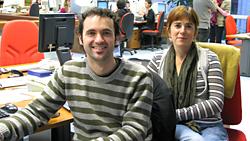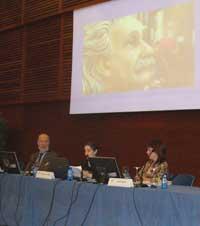Text written in Basque and translated automatically by
Elia without any subsequent editing.
SEE ORIGINAL
Scientific lines in press
2008/11/01
Roa Zubia, Guillermo - Elhuyar Zientzia
Iturria:
Elhuyar aldizkaria
Technology, health and information technology have been the most common scientific topics in newspapers published in Euskal Herria during the first four months of 2008. However, if we look at newspaper covers, the classification changes: health issues are the ones that have appeared most on the surfaces, followed by the environment and technology, in second and third place, respectively.
Scientific lines in press
01/11/2008 | Roa Zubia, Guillermo | Elhuyar Zientzia Komunikazioa
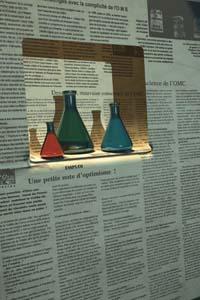
(Photo: G. Roa)
These are some of the results of a study conducted by the Elhuyar Foundation. The aim was to analyze the press published in the Basque Country and to this end eleven newspapers have been analyzed (Berria, Deia, Diario de Navarra, El Correo Español, El Diario Vasco, Gara, Le Journal du Pays Basque, Diario de Noticias, Noticias de Gipuzkoa, Noticias de Alava and Sud Ouest). The study took into account the copies published between 1 January and 30 April 2008. In order to analyze the presence of science in the press, we wanted to collect all the texts that deal with scientific, technological or innovation issues.
In total they have received 6,448 texts. Most of the texts are published in Spanish, 82%, language in which most of the analyzed media are published. Most of the texts have been published by the two newspapers of the group Vocento, El Correo Español and El Diario Vasco (932 and 741 texts respectively), being the third in this classification Noticias de Gipuzkoa (715 texts).
Science is not important
Most of the published texts have been of very little importance (1,089 texts), attending to the scale of importance of Richard Budd (depending on the size of the news, the space it occupies, the number of the page and its graphical use), while the texts of great importance have been only 55.
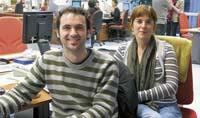
Garikoitz Otamendi, Ixabel Charritton and Bego Zubia have formed the team. In the picture, Garikoitz Otamendi and the Bego Bridge.
R. Cardboard
The results of the study show that journalists often choose topics related to technology, health, computer science and the environment when preparing scientific, technological and innovative information.
When it comes to addressing these issues, newspapers tend to offer mere information -- long and short news -- although they cannot be said to abandon the interpretative genre.
It has also become clear that newspapers do not have much opinion on science, technology and innovation, much less on their own opinions. Eleven newspapers have only published 26 editorials.
"Although there is little, there are more and more articles of opinion, it has caught my attention," says Bego Zubiak, head of the study. "Publishers and opinion articles are few, but they are growing. This means the need to reflect on these issues."
Positives predominate
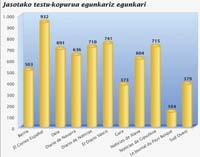
(Photo: C.M. Urdangarin)
In any case, it can be said that newspapers are positioned in favor of science, innovation and technology, even if they do not directly. In fact, most of the information published has a positive view, although in journalism, in general, bad news is more likely to become news than good news.
In the newspapers, official information on science, technology and innovation predominate in both the Basque Country and Europe, since more than half of the sources, 60%, were institutions. It should not be forgotten that 25% of the texts cannot say where the news was born or who is responsible for the information, since the newspapers have not provided this data.
Another interesting fact is that of the section in which scientific news is published in newspapers. This study has shown that science today is not exclusively about research. "In the first blow I was surprised that most of the scientific news is in free time and in cultural pages," says the Bridge. "But if we analyze it, it is not so surprising, because many of the things in these sections have to do with technology. For example, there is a lot of engine and computing, computers and new communication tools."
Looking at Europe
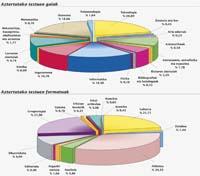
(Photo: C.M. Urdangarin)
The study is a reflection of the press published in Euskal Herria, but the results obtained are similar to those of other broader studies. This work also aims to collect it, and for this it has been compared with a study carried out at European level. This is a study published by the European Union in December 2007 that reflects the perception of journalists in the European Research in the Media: what do Media Professionals think? (European media research: What do media professionals think? ).
The comparison shows that the topics chosen by the Basque media to deal with issues of science, technology and innovation are similar to those chosen by the European partners, and that the problems of identification of the origin and the author of the news are not exclusive to Basque journalists, since European professionals highlight the same problem among the challenges they face.
Science in the media: two opinions
Txema Ramírez de la Piscina
Is science increasingly treated in the media?
Yes, no doubt. In addition, the results are there, science is occupying more and more space in all media, both in press, radio, television and internet. That means there is concern. Often it is said that there is very little talk of scientific journalism, but then everyone talks about the Geneva LHC accelerator, perhaps with an empty story. My daughter told a friend of mine that the end of the world will come. This person's reading is wrong, but at least it has been talked about. A few years ago it was almost unthinkable that something like this happens: The news of the prestigious LHC appeared in all news reports.
What is your experience like?
I teach the subject of Specialized Journalism at the University of the Basque Country/Euskal Herriko Unibertsitatea, within which scientific journalism is framed. Every year I ask students a question: who do you like science journalism? And little dare to raise your hand. Other disciplines such as sports journalism are much more successful. That seems a bit the measure of what happens around scientific journalism.
In reality, there are many prejudices about science; we have always seen it difficult, boring, elitist and minority. And sometimes it is so. Sometimes things get complicated or disseminators don't get right. But we also have to tell the truth: great efforts are made and we have increasingly better disseminators in all places and disciplines. And, thanks to this, I believe that scientific journalism is spreading more and more, because, on the one hand, many of the profiles of science have come to the field of communication and, on the contrary, many professionals from the world of communication have gone to the world of science. This symbiosis, this work of bridge, is essential to be able to correctly carry out scientific disclosure.

Txema Ramírez de la Piscina
(Photo: UPV)
What does scientific news do well?
The media used by the journalist to facilitate its complexity. For example, it can be a very complex issue, but if the journalist is able to explain things through a beautiful analogy, with very close examples, this will facilitate things and greatly facilitate the absorption of readers or listeners. But it is often difficult.
First, the journalist has to be curious, he has to be constantly questioned. If you conform to that version you have always given us, then you have no jacket. And it is essential. The daring to enter unknown areas, The sapere is! (we dare to think for ourselves), it is essential. That said: to be a good disseminator uses analogies, uses metaphors, close examples and humor, why not. We have always thought that science is boring, and that is not at all true. We have to learn to spread through entertainment. In many places it is demonstrated day by day that it is possible and we have to get it between us.
Michel Claessens
Head of the Information and Communication Unit of the Directorate General for Research of the European Commission.
Is science increasingly treated in the media?

Michel Claessens
(Photo: European Commission)
I think there are advances on the one hand, but on the other there are delays. Advances: good scientific pages in the European press and good radio and television programs. In addition, I see more and more informative elements of science and technology being incorporated. The New York Times policy is an example to follow. To address an important issue they always put to work a team that includes a scientific journalist. For example, in the team that announced the Iraq war, there was a scientific journalist.
Delays: some media face difficulties and some scientific journalists (the largest proportion of freelancer is in scientific journalism). And it is observed that in any media the pillars of science compete with other topics. And some media have completely stopped treating science. Our latest Eurobarometer, on December 2007, showed that, in general, Europeans are satisfied with how the media handle science.
What has been your experience?
I have had a positive experience with the media. I am a chemist and I like to say that scientists and journalists are the same in many things. However, I believe that scientists do not properly respect the work of journalists. Investigative journalism is essential in democracy.
Are the media available to the material you send?
In general, the media response is good. But we try to be selective and we do not send them news of little importance or real so that they do not drown. We see that journalists like one-topic briefings (floods, health research, etc.). ). In these cases, we try to present journalists with the best European research (and the best researchers, between 3 and 4 speakers) and teach them research resources. They like it very much. One of the biggest problems of the media is excessive information. These meetings provide original and quality information to journalists.
Roa Bridge, Guillermo
Services
247
2008
Results
032
Humanities; Elhuyar news
Article
Resources










